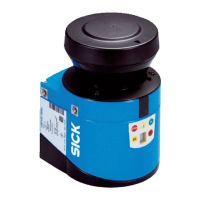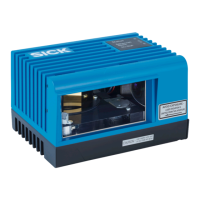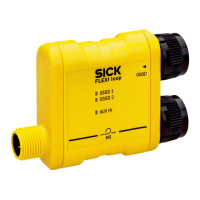Operating Instructions
LMS5xx
Annex
8013796/ZM63/2017-05-09 © SICK AG · Germany · All rights reserved · Subject to change without notice 117
Chapter 11
11.5 List of Figures
Fig. 1: Laser output aperture of the LMS5xx .................................................................. 13
Fig. 2: Status indicators .................................................................................................... 19
Fig. 3: Measuring principle of the LMS5xx ...................................................................... 20
Fig. 4: Principle of operation for time of flight measurement ........................................ 21
Fig. 5: Reflection of the laser beam at the surface of an object ................................... 22
Fig. 6: Reflection angle ..................................................................................................... 22
Fig. 7: Degree of reflection ............................................................................................... 22
Fig. 8: Mirror surfaces ...................................................................................................... 23
Fig. 9: Object smaller than diameter of the laser beam ................................................ 23
Fig. 10: Scanning range of the LMS5xx as a function of the target remission ............... 24
Fig. 11: Beam expansion .................................................................................................... 24
Fig. 12: Schematic layout of the distance between measured points
at different angular resolutions ............................................................................ 25
Fig. 13: Beam diameter and distance between measured points
of the LMS500 at 0 to 80 m (0 to 262.47 ft) ...................................................... 25
Fig. 14: Minimum object size for detection ....................................................................... 26
Fig. 15: Measured value telegram request ....................................................................... 30
Fig. 16: Continuous measured value output ..................................................................... 31
Fig. 17: Principle of operation of the measurement
of the fifth received echo (LMS5xx PRO) ............................................................. 32
Fig. 18: Typical RSSI values HR ......................................................................................... 33
Fig. 19: Typical RSSI values SR .......................................................................................... 34
Fig. 20: Principle of the field application ........................................................................... 35
Fig. 21: Protection against tampering due to shading and glare .................................... 37
Fig. 22: Examples of 4 different evaluation field shapes ................................................. 38
Fig. 23: Logical operators for inputs and outputs ............................................................. 41
Fig. 24: Increase in the size of the beam and safety supplement .................................. 44
Fig. 25: Direct mounting ..................................................................................................... 48
Fig. 26: Mounting with mounting kit 1 ............................................................................... 48
Fig. 27: Mounting with mounting kits 1 and 2 .................................................................. 49
Fig. 28: Mounting with mounting kits 1, 2 and 3 .............................................................. 50
Fig. 29: Weather protection hood, upright orientation of the scanner ............................ 51
Fig. 30: Weather protection hood, upside down orientation of the scanner .................. 51
Fig. 31: Placement of two LMS5xx opposed to each other .............................................. 52
Fig. 32: Crosswise placement of two LMS5xx ................................................................... 52
Fig. 33: Placement of two LMS5xx with parallel offset .................................................... 52
Fig. 34: Placement of two LMS5xx with parallel offset, one of these upside down ....... 53
Fig. 35: Placement of two LMS5xx upside down, parallel offset ..................................... 53
Fig. 36: Placement of two LMS5xx with parallel offset, one of these upside down ....... 53
Fig. 37: Currents in the cable shields due to differences in ground potential ............... 55
Fig. 38: Use of electro-optical signal converters ............................................................... 56
